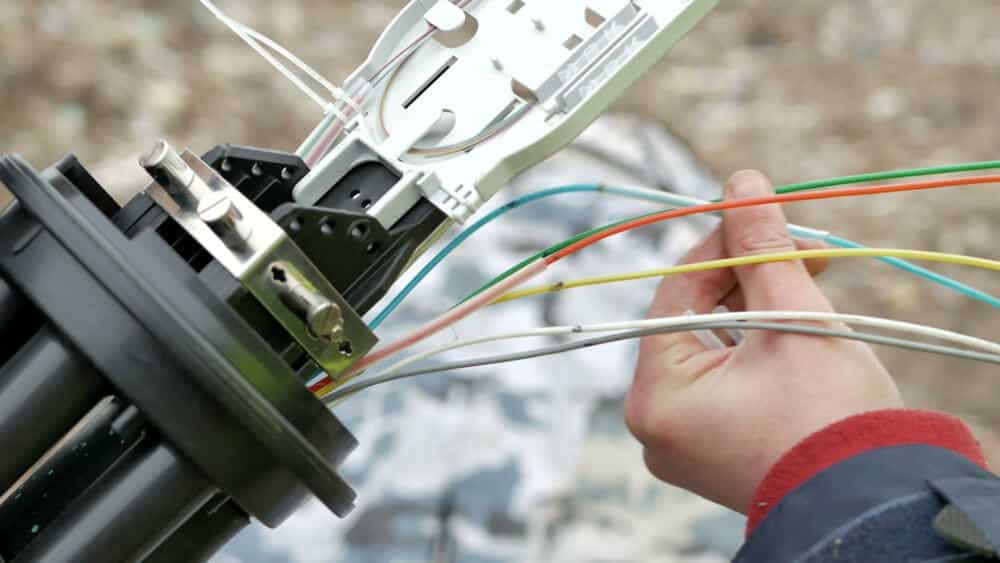Exploring the Difference Between Cable and Fiber Internet
In today’s world, you can’t get far without a solid internet connection. The internet connects us to information, socialization, business operations, and more. Businesses across the country are discovering the benefits of SD-WAN services, Contact Center as a Service (CCaaS), and fast internet.
There are many ways faster internet enhances business operations, including higher productivity levels, robust security, and efficient cloud access. There are two primary types of internet: cable and fiber. Let’s take a look at the differences and similarities of cable internet vs. fiber internet and narrow down which type is best for your business.
What Is Cable Internet?
Cable internet is also referred to as broadband internet. Cable internet is quite literally delivered using cables. The same copper coaxial cables that provide cable television also deliver cable internet. A coax cable can supply internet and television connections at the same time. The wires are comprised of:
- A copper core
- An insulating sheath
- Copper and aluminum shields
- A plastic outer layer
Typically, a cable internet modem delivers internet, but neighborhoods and areas connect each network. Connections from different households, offices, or businesses converge together, often on a utility pole on the street, and they share bandwidth.
How Fast Is Cable Internet?
Cable network speed can usually accommodate large downloads. However, since the network is connected and shared by neighborhoods, slow speeds often occur during high usage times. If your business is located in a highly populated area, you may experience dramatic slowdowns during peak business hours when you need to be productive.
Cable download speeds range from 10 to 500 megabits per second (Mbps). The upload speed range is 5 to 50 Mbps. You select your preferred speed when you sign up for cable internet. The higher the speed, the more money you pay. Even still, the speed you pay for isn’t guaranteed. Many cable service providers have data caps, and if you go over the data limit, you may need to pay additional fees.
Cable Network Availability
Cable networks are available just about everywhere across the country. If you live in an area where you can access a television network, you can also access cable internet. Cable internet is available in all 50 states and has 89% coverage across the United States. Cable internet availability is higher in urban areas compared to rural areas.
Cable Reliability
For the most part, cable internet for business is very reliable. However, electricity outages can affect cable connection. Cable internet is not as reliable in areas with frequent electricity outages and cable interruptions. Backup internet sources may be needed during power outages. Even still, cable internet is more reliable than other internet sources such as digital subscriber lines (DSL) or satellites.

What Is Fiber Optic Internet?
Now that you have an understanding of cable internet, let’s explore the offerings of fiber internet. While cable internet uses copper cables, fiber internet uses fiber optic cables to deliver internet to homes and businesses. Fiber optic cables are comprised of optical fibers, which are incredibly thin strands of glass or plastic.
Fiber utilizes LED or laser pulses to transfer internet data over long distances. Fiber cables carry more bandwidth than copper cables, which makes fiber internet a popular choice. Fiber internet technology is newer, so it is not as widely used as cable internet.
How Fast Is Fiber Internet?
Fiber internet is the fastest internet available today. Fiber cables can transfer large amounts of data without delays in processing. Additionally, fiber optic internet does not have bandwidth caps, so you can use as much as you need.
Fiber internet does not share networks, so peak-time lags are not an issue as with cable internet. High-speed business fiber internet help improves productivity and customer satisfaction. Fiber speeds for uploading and downloading are no less than 250 to 1,000 Mbps, which is significantly faster than traditional broadband internet.
Fiber Network Availability
Fiber internet is still in an expansion stage, so connections are not as easily accessible as cable internet. However, as fiber internet gains popularity, it is becoming more available. Fiber optic internet would be more difficult for rural businesses to obtain, but it is more accessible in metropolitan areas.
Fiber Reliability
Fiber internet is incredibly reliable. Electricity disruptions do not affect fiber network availability, so internet connections continue if the electricity goes down. This reliability is because fiber optic cables are made of glass, and they do not conduct electricity.
It is incredibly rare for a fiber network to get interrupted. This consistent network reliability makes a considerable difference in productivity for businesses when they need it most.
The Best Choice for Businesses
Fiber internet is the most efficient choice for businesses in metropolitan areas with access to fiber. Fiber internet boasts the fastest speeds, large bandwidth capacities, and network reliability unimpacted by power outages. Companies with high productivity demands will find that fiber internet best suits their needs.
For rural companies or businesses with less demanding needs, cable internet is suitable. If businesses don’t have many content needs, mission-critical internet applications, or on-location servers, cable internet can adequately meet their needs while saving a little bit of money.
Are You Ready to Upgrade Your Internet?
Even though cable and fiber internet have many similarities, they also have differences that distinguish them from each other. Gone are the days of satellite and dial-up internet connections. At a minimum, businesses need cable internet to operate. However, the best way to improve speed, productivity, and reliability is by installing fiber internet.
Are you curious to know if fiber internet is right for your business? Integrated Communications can help. We will perform a free telecommunications and networking audit for your business. Don’t wait any longer to determine how your business can improve user experience, save money, and increase productivity; instead, contact us today!
4 Ways Your Business Can Benefit From SD-WAN
In today’s business landscape, companies need to adapt to the latest technology or risk losing valuable sales to their competition. From high-speed fiber-based internet to Contact Centers as a Service (CCaaS), businesses across the United States are improving their performance with modern, efficient services.
Another valuable service for businesses is a software-defined wide area network (SD-WAN). SD-WAN services optimize software and applications necessary for business operations because traditional WANs no longer hold up to today’s connectivity needs. Still on the fence about switching your business over to SD-WAN? Let’s dive into SD-WAN and its four significant benefits.
What Is SD-WAN?
Business SD-WAN solutions are essential for optimizing online traffic. SD-WAN services move traffic away from slow, hardware-based storage solutions on traditional wide area networks (WANs) to the preferred method of storage: the cloud. “The cloud” refers to servers that are accessed over the internet rather than computer hard drives. Software and databases can run through the cloud, which frees up storage space, and ultimately allows processes to run smoother and faster.
Why Don’t Traditional WAN Systems Work Anymore?
Original WAN systems work by hosting servers at a data center and connecting additional users to the original server. An example of this is a traditional internet router you may have in your home. Older WAN systems were not designed to accommodate modern cloud traffic.
Therefore, WAN systems often experience backhauls because they can’t meet today’s traffic and data demands. These backhauls lead to delays, lost productivity, and poor user experience.
As businesses continue to adopt software as a service (SaaS) and infrastructure as a service (IaaS) on multiple clouds, companies need to switch to SD-WAN to provide high-quality user experiences.
If businesses keep their traditional WAN services, they will experience an incompatible traffic explosion when they mix cloud-based services and hard-drive-based services. This traffic incompatibility results in:
- Poor user experience
- Decreased employee productivity
- Rising WAN expenses
- Increased security threats
- Unpredictable application performance
That’s where SD-WAN comes in. Since SD-WAN systems are optimized for the cloud, businesses no longer have to deal with frustrating backhauls and poor application performances. SD-WAN allows enterprises to securely connect users to applications by utilizing any combination of transport services, including:
- Long-Term Evolution (LTE)
- Multiprotocol Label Switching (MPLS)
- Broadband internet
4 Major SD-WAN Benefits for Business
SD-WAN benefits are plentiful, so it’s easy to understand why so many businesses are making the switch. SD-WAN is the answer to all of the issues and difficulties businesses experience when they try to mix cloud services and traditional WAN.
SD-WAN services can be set up quickly, and your business will immediately see the benefits roll in. SD-WAN offers a multitude of advantages for businesses, but the four significant benefits that attract business owners are:
1. Increased Security
When businesses mix traditional data centers and cloud operations, they experience security concerns. The two different systems are not compatible, so data becomes vulnerable when traffic moves across systems. As more and more software and data exist on the cloud, protecting traffic for business-critical operations is vital.
One of the best perks of SD-WAN is that it comes with built-in security. Integrated security features help prevent things such as:
- Lost data
- Downtime
- Legal liabilities
- Regulatory violations
Customers and clients can rest at ease knowing their private information is secure in the cloud with SD-WAN services. Integrated threat protection features are enforced at the right time and place, so businesses can catch security breaches before they happen.
2. Improved Performance
SD-WAN simplifies the management of networking services for small businesses. Simplifying operations from a central portal results in ease of performance. SD-WAN can even be configured to prioritize critical traffic and real-time services such as Voice over Internet Protocol (VoIP).
Traffic for high-demand applications gets routed through the fastest connection. Prioritizing the most critical traffic allows SD-WAN networks to reduce standard performance issues such as lagging and jittering.
With SD-WAN, fast networks are highly available and predictable, so businesses can rely on consistent performance when it matters most.

3. Lower Costs
One of the main reasons businesses switch to SD-WAN is because of how cost-effective it is. Since SD-WAN services utilize technology that you already have, such as ethernet or WiFi, your business doesn’t need to spend money on complicated new equipment or IT services.
Essentially, SD-WAN helps you get the highest performance out of the connectivity you already have, so there is no need to pay for extreme IT involvement or new overhead costs. SD-WAN solutions only use the circuits they need to get the job done.
SD-WAN leverages low-cost local internet access, reduces unnecessary traffic, and provides direct cloud access. The automated management feature on SD-WAN systems removes the need for network engineers to make system changes and reduces the effort needed to maintain a network. All of these modern functions reduce usage and labor costs.
4. Optimized Cloud Experience
Businesses and the general public are utilizing cloud storage more and more each day. The average person who used to store digital photos and documents on computer hard drives now can easily access them through cloud applications such as:
- Google Photos
- Dropbox
- Microsoft OneDrive
- Google Drive
- Apple iCloud
- And more
SD-WAN is continually being revamped to provide optimized connectivity over the cloud. SD-WAN is appealing because it dramatically simplifies cloud connectivity compared to traditional WAN services. It can automate simple tasks and organize complex tasks in the most efficient way.
Gone are the days of needing to be connected to a centralized data center. With SD-WAN for business, employees can access cloud applications remotely to be productive from any location.
Optimize Your Business With SD-WAN Today
As you can tell, there are numerous reasons why businesses across the country are switching from traditional WAN services to SD-WAN. Don’t let your competition get ahead. Instead, take advantage of cost-effective SD-WAN services that will increase your security and performance.
At Integrated Communications, we partner with the most trusted SD-WAN providers in North America. Are you ready to make the switch? Contact us today to set up a free telecommunications audit. We will assess your company’s performance and help you determine the best path forward for your business network.


